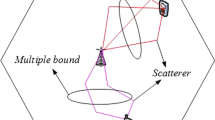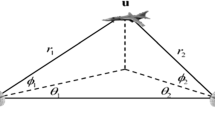Abstract
A single base station (BS) localization approach is proposed in this paper when the BS measures time of arrival (TOA) and angle of arrival (AOA). As the mobile stations (MSs) are gradually evolving to become sophisticated wireless access devices rather than just pocket telephones, the angle of departure (AOD) can also be obtained. Based on the circular scattering model, a nonlinear constrained optimization localization approach is formulated by introducing the coordinate of scatter. More accurate localization results with AOD and AOA informations can be achieved by reducing the feasible area among the coordinates of scatter, MS, and BS. Due to the measurement errors, the AOD and AOA measurements may decide incorrect relation among them. Then, the theoretic probabilities of wrong decision about the solo judgment of AOD measurement and joint judgment of AOD and AOA measurements are analyzed and derived, respectively. Simulation results demonstrate that the proposed approaches give better performance compared to the existing approaches, and the theoretic probabilities of wrong decision are consistent with simulation results.







Similar content being viewed by others
References
Caffery J Jr, Stuber GL (1998) Subscriber location in CDMA cellular networks. IEEE Trans Veh Technol 47(2):406–416
Cong L, Zhang W (2002) Hybrid TDOA/AOA mobile user location for wideband CDMA cellular systems. IEEE Trans Wirel Commun 1(3):439–447
Venkatraman S, Caffery J, You HR (2004) A novel ToA location algorithm using LoS range estimation for NLoS environments. IEEE Trans Veh Technol 53(5):1515–1524
Venkatranman S, Caffery J (2004) Hybrid TOA/AOA techniques for mobile location in non-line-of-sigh environments. In: Proc Wireless Communications and Networking Conference (WCNC) 1:274–278
Al-jazzar S, Ghogho M, Mclernon D (2009) A joint TOA/AOA constrained minimization method for locating wireless devices in non-line-of-sight environment. IEEE Trans Veh Technol 58(1):468–472
Xie Y, Wang Y, Zhu P, You X (2009) Gird-search-based hybrid TOA/AOA location techniques for NLOS environments. IEEE Commun Lett 12(4):254–256
Mazuelas S, Lago FA, Blas J, Bahillo A, Fernandez P, Lorenzo RM, Abril EJ (2009) Prior NLOS measurement correction for positioning in cellular wireless networks. IEEE Trans Veh Technol 58(5):2585–2591
Wu S, Li J, Liu S (2011) Improved localization algorithms based on reference selection of linear least square in LOS and NLOS environments. Wirel Pers Commun. Published online first
Wu S, Li J, Liu S, Chong J-W (2012) Improved and extended range scale algorithm for wireless cellular location. IEEE Commun Lett 16(2):196–198
Wu S, Li J, Liu S (2013) Improved localization algorithms based on reference selection of linear least squares in LOS and NLOS environments. Wirel Pers Commun 68(1):187–200
Wu S, Dengyuan X, Wang H (2015) Adaptive NLOS mitigation location algorithm in wireless cellular network. Wirel Pers Commun 84(4):3143–3156
Pejovic P, Simic M (2015) Improving precision of mobile positioning in highway environments. Ann Telecommun 70(11):491–500
Zhang S, Gao S, Wang G, Li Y (2015) Robust NLOS error mitigation method for TOA-based localization via second-order cone relaxation. IEEE Commun Lett 19(12)
AI-Qaisi A, Alhasanat AI, Mesleh A et al (2016) Quantized lower bounds on grid-based localization algorithm for wireless sensor networks. Ann Telecommun 1–11
Silventoinen MI, Rantalainen (1996) Mobile station emergency locating in GSM. In: Proc IEEE International Conference on Personal Wireless Communication, New Delhi, India, p 232–238
Tang H, Park YW, Qiu TS (2008) A TOA-AOA-based NLOS error mitigation method for location estimation. EURASIP J Adv Signal Process 2008:Article ID 682528, 14 pages
Zhaounia M, Landolsi MA, Bouallegue R (2008) Hybrid TOA/AOA mobile localization with NLOS mitigation in ring scattering environments. In: Proc Wireless Pervasive Computing, Santorini, p 370–373
Zhaounia M, Landolsi MA, Bouallegue R (2010) Mobile positioning in a Gaussian scattering channel model. The IEEE Symposium on Computers and Communications, Riccione, Italy, p 671–673
Shixun W, Dengyuan X, Wang H (2015) Joint TOA/AOA location algorithms with two BSs in circular scattering environments. WSEAS Tran Commun 14:235–240
Shixun W, Dengyuan X, Tan J, Xu K, Wang H (2016) Two base station location techniques with adjusted measurements in circular scattering environments. Int J Commun Syst 29(6):1073–1083
Porretta M, Nepa P, Manara G, Giannetti F, Dohler M, Allen B, Aghvami AH (2004) A novel single base station location technique for microcellular wireless networks: description and validation by a deterministic propagation model. IEEE Trans Veh Technol 53(5):1502–1514
Tsalolikhin E, Bilik I, Blaunstein N (2011) A single-base-station localization approach using a statistical model of the NLOS propagation conditions in urban terrain. IEEE Trans Veh Technol 60(3):1124–1137
Miao H, Yu K, Juntti MJ (2007) Positioning for NLOS propagation: algorithm derivations and cramer-rao bounds. IEEE Trans Veh Technol 56(5):2568–2580
Seow CK, Tan SY (2008) Non-line-of-sight localization in multipath environments. IEEE Trans Mob Comput 7(5):647–660
Ertel RB, Reed JH (1999) Angle and time of arrival statistics for circular and elliptical scattering models. IEEE J Sel Areas Commun 17(11):1829–1840
Jazzar SA, Caffery J, You HR (2007) Scattering-model-based method for TOA location in NLOS environments. IEEE Trans Veh Technol 56(2):583–593
Jami I, Ormondroyd R (2000) Estimation of the scattering aroud a mobile handset using a sub-space technique. IEEE Information Systems for Enhanced Public Safety and Security, p 131–135
Gill PE, Murray W, Wright MK (1981) Practical optimization. Academic, Boston, MA
Acknowledgment
This research was supported by the Science and Technology Research Project of Chongqing Municipal Education Commission (KJ1400305), Foundation and Frontier Research Project of Chongqing (cstc2016jcyjA0365,cstc2013jcyjA30017), Natural Science Foundation of China (no. 61573706, no. 61304104, no. 51308573), the Scientific Research Foundation for the Returned Overseas Chinese Scholars (no. 2015-49), Program for Excellent Talents of Chongqing Higher School(no. 2014-18), open fund project of key Laboratory of Hydraulic and Waterway Engineering of the Ministry of Education and National Engineering Research Center for Inland Waterway Regulation in Chongqing Jiaotong University (SLK2016A01), and open fund project of state key laboratory cultivation base for mountain bridge and tunnel engineering (CQSLBF-Y16-7).
Author information
Authors and Affiliations
Corresponding author
Rights and permissions
About this article
Cite this article
Wu, S., Xu, D., Zhang, S. et al. Single base station hybrid localization with scatter and angle of departure in circular scattering environment. Ann. Telecommun. 71, 649–655 (2016). https://doi.org/10.1007/s12243-016-0535-6
Received:
Accepted:
Published:
Issue Date:
DOI: https://doi.org/10.1007/s12243-016-0535-6




